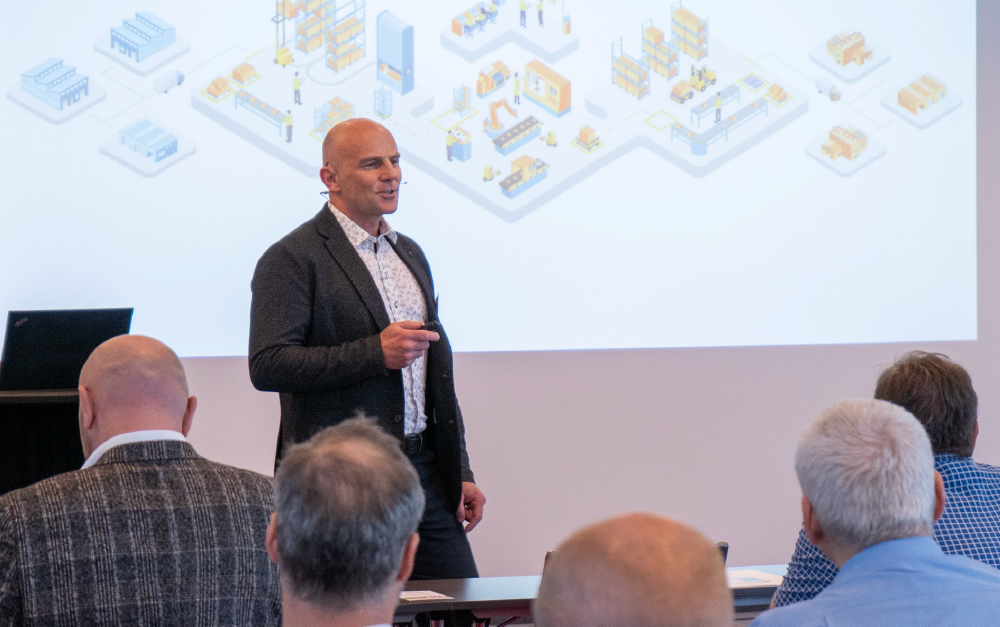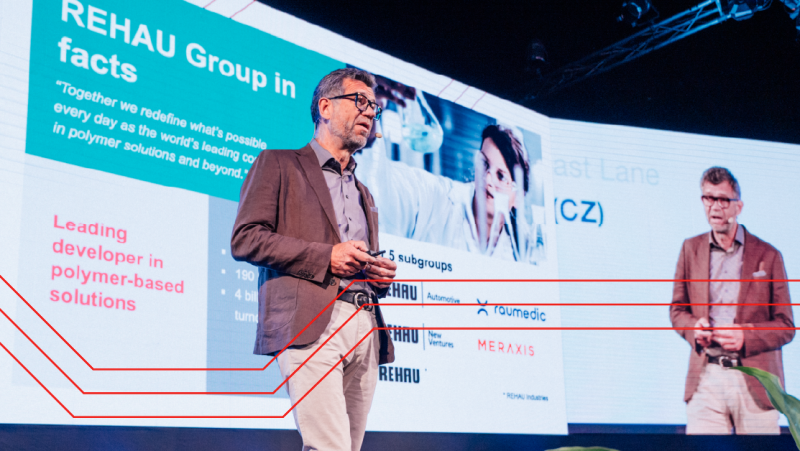With DCIx7, the dream of a digitalisation platform running in the cloud becomes a reality
- Digital Factory
- Article
The User Group for Aimtec’s DCIx met up at the start of this May in Pilsen, and attendees could learn what visions are out there for logistics and what new features DCIx will soon have in store. Representatives from Koito Czech and Continental Automotive showed their approach to automation via practical examples. The event also included morning workshops about advanced stock management with WMS, new processes in MES and the role of DCIx in the digital factory. Couldn’t be there, or want a refresher on a few key points? Watch the presentations from the main afternoon section.
Riding DCIx into the clouds
A digitalisation platform can interconnect information systems and hook in robots and machines. That lets an order travel from an ERP all the way to a machine, and lets the data return to the system. Using this platform, changes can be implemented and processes can be configured without supplier intervention. What’s the future of cloud solutions and logistics free of scanners and other devices that just slow you down? Rostislav Schwob, Supply Chain Solutions Director at Aimtec, spoke on all of this. Aimtec’s latest – DCIx7 – is a cloud solution as well. Jan Kocián, Software Development Director at Aimtec, described what it provides in addition to security and increased accessibility.
Logistics automation
New projects for the complete automation and digitalisation of logistics are arriving every day. Most of them are not simple, and they extend DCIx to include more features and hook in new equipment and technologies. What are this project’s main phases, how long will they take, and why is logistics data collection needed in the first step? How important are flexibility and configurability, and what is a breakdown into individual transactions good for? Daniel Choc, Senior Business Consultant at Aimtec, explained all this, as well as the benefits of working with SKLAD on automation projects.
Reporting
Data acquisition and assessment are becoming a day-to-day part of logistics. Reporting is also used for tactical and strategic decision-making. When is it more appropriate to use the Built-in Report vs. the Realtime Report? Why choose a data warehouse over a manufacturing database? Software Development Manager Jiří Tuma and Sales Manager Daniel Vopelka from Aimtec described what a data warehouse actually looks like and how it works in cooperation with Power BI. They also spelled out how to present current and historical data in 3D using digital twins and how to verify processes.
Case Study: Koito Czech
Production of 1.8 million front car headlamps a year with 1,350 employees – DCIxMES has been helping Koito Czech with this challenge since 2019. Under the leadership of Jan Šavrda, Group Leader at Koito Czech, DCIxMES has been deployed for presses, surface treatment, pre-assembly and the main assembly line. At present 103 workstations equipped with HMI touch panels are in operation – signals are received by DCIx from 80 machines. What were the expectations for this project, and what are its benefits? What reports do they use at Koito, what do they show, and how has it actually helped Koito’s manufacturing and logistics?
Case Study: Continental Automotive
The production facilities at Continental Automotive’s Brandýs plant stretch out over 28,900 m2. This plant with 2,800 employees manufactures 26.1 million products per year. The DCIx warehouse management system alone registers 550,000 warehouse units. Meanwhile, DCIx manages such technologies as the VNA stackers, the AGVs, the Omrons, conveyor systems, Kardexes, and newly the unique AutoStore storage system as well. What do data warehouses look like in practice? What do digital twins have to offer? Miloš Havlíček, Process and Tools Manager, and Josef Murgaš, Warehouse Project Manager at Continental Automotive, answered these questions.
Supply chain integration
Supply chains today are full of visions, such as visibility and digitalisation. But what’s the reality? How can you send orders and call-offs, receive ASNs and exchange other documents automatically? One example of a comprehensive pilot project here is the SEAT Control Tower, presented to the User Group by Jan Stočes, Cloud & Integration Solutions Director, and Marek Šabatka, Cloud Business Development Manager at Aimtec. This system keeps SEAT aware of what its suppliers have in stock. SEAT has an overview of its production and warehouses and is simultaneously plugged in to information from its suppliers. It can also easily determine which colour is in style at the moment.
The latest from Zebra Technologies
Delivery times for certain equipment are getting longer, and changing one’s supply chain isn’t easy. Despite all this, Zebra always tries to be proactive and keeps bringing new products to market. Among them is an Android computer that can be worn on your wrist – but not just there. What’s hidden under such names as “TC53” and “TC58”, and what are some other new technologies? Petr Stejskal, Chief Technology Officer at Aimtec, and Marek Písečný, Channel Manager Czech and Slovakia at Zebra Technologies CZ, also presented Zebra VisibilityIQ Foresight. Listen and learn how this cloud service is used.
Share article
Top stories from logistics, production and IT.
Subscribe to Aimtec Insights
By registering, you agree to the processing of your personal data by Aimtec as described in the Privacy policy.
Get top stories and articles
from Logistics, Production and IT.
Subscribe to Aimtec Insights
By registering, you agree to the processing of your personal data by Aimtec as described in the Privacy policy.







